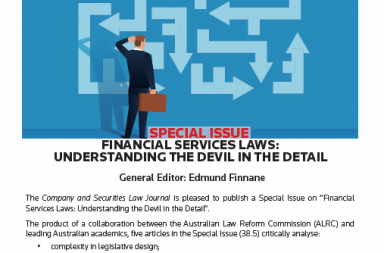*Please note that the links to the content in this Part will direct you to Westlaw AU.
To purchase an article, please email: [email protected] or contact us on 1300 304 195 (Australian customers) or +61 2 8587 7980 (international customers) during business hours (Mon-Fri, 8am-6pm AEST).
The latest issue of the Australian Law Journal (Volume 97 Part 11) contains the following material:
CURRENT ISSUES – Editor: Justice François Kunc
- The Voice to Parliament Referendum
- ACT Board of Inquiry
- A Lawyer Gives Opinions Not Risk Assessments
- A Judge Held Liable for False Imprisonment
- Indigenous Australians and the Law
- New Family Law Section Editor
- Links with London Redux
- Links with London
- The Curated Page
CONVEYANCING AND PROPERTY – Editors: Robert Angyal SC and Brendan Edgeworth
- Compensation for Loss under the Torrens System: Ausbao (286 Sussex Street) Pty Ltd v Registrar General of New South Wales
FAMILY LAW – Editor: The Hon Justice Grant Riethmuller
- Evidence and Unacceptable Risk
FROM THE LAW SCHOOLS – Editor: Emeritus Professor David Barker
- Australasian Law Academics Conference 2023
PERSONALIA – Editor: Emily Vale
- The Judicial Role as an Expression of the Whole Personality: Supervision of Public and Private Power By the Courts and the Legacy of Chief Justice Allsop
- Appointments
- Commonwealth
- Chief Justice Debra Mortimer
- Justice Ian Jackman
- Australian Capital Territory
- Justice Verity McWilliam
- New South Wales
- Justice Sarah McNaughton
- Justice Deborah Sweeney
- Justice Richard Weinstein
Articles
Burying Certiorari for Error of Law on the Face of the Record – Declan Noble and Kate Thomas
In Probuild Constructions (Aust) Pty Ltd v Shade Systems Pty Ltd in 2018, Gageler J questioned the historical foundations of certiorari for error of law on the face of the record and hinted at the doctrine’s possible “burial”. In this article, we take up that invitation, and show that the doctrine was, as it were, invented by the English Court of Appeal in R v Northumberland Compensation Appeal Tribunal; Ex parte Shaw in 1951. The doctrine is premised on a misreading of older authority. The true position is that certiorari was always concerned with jurisdiction and, save for the peculiar procedure of using certiorari to state a case to King’s Bench, decisions were never quashed for mere error of law. Not only is the doctrine historically suspect, it is inconsistent with other aspects of modern Australian administrative law and should be “buried”. This article also considers how statutes which refer to the doctrine should now be construed.
The Turbulent Effects of COVID-19 Policy on Australian Federalism and National Uniform Legislation – Guzyal Hill and John Garrick
The COVID-19 pandemic prompted intergovernmental reforms across nine jurisdictions in Australia, with divergent state policies reviving debates about the core federal structure. This article probes the effects of the divergent COVID-19 policies on the federation and examines how state responses can, in future, strengthen federation by considering unique regional characteristics within a national context. Advocacy coalitions, such as public health, business and economic, have influenced policy responses, some seeking strict measures to contain the virus others prioritising economic recovery. This study identifies that the divergent and incremental post-pandemic legislation occurring within individual jurisdictions may lead to divisions that may not be beneficial for the next emergency. Rushing into expedient legislation that serves one jurisdiction may not produce optimal outcomes for that state or Australia as a whole, especially when shaped by strong local advocacy coalitions. Longer-term considerations and a more cohesive approach are necessary to ensure best outcomes for the states, territories and the Australian federation.
For the PDF version of the table of contents, click here: New Westlaw Australia – ALJ Vol 97 No 11 Contents.
Click here to access this Part on New Westlaw AU
For general queries, please contact: [email protected].


